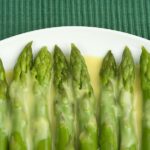Brussels sprouts have a nutty, cabbage-like flavor that makes a delicious hot side dish dressed with butter or meat-roasting juices.
Lightly steamed Brussels sprouts are perfect with a lemon-butter sauce, or you can simmer them with chopped celery until tender and then fold them into a cheese sauce.
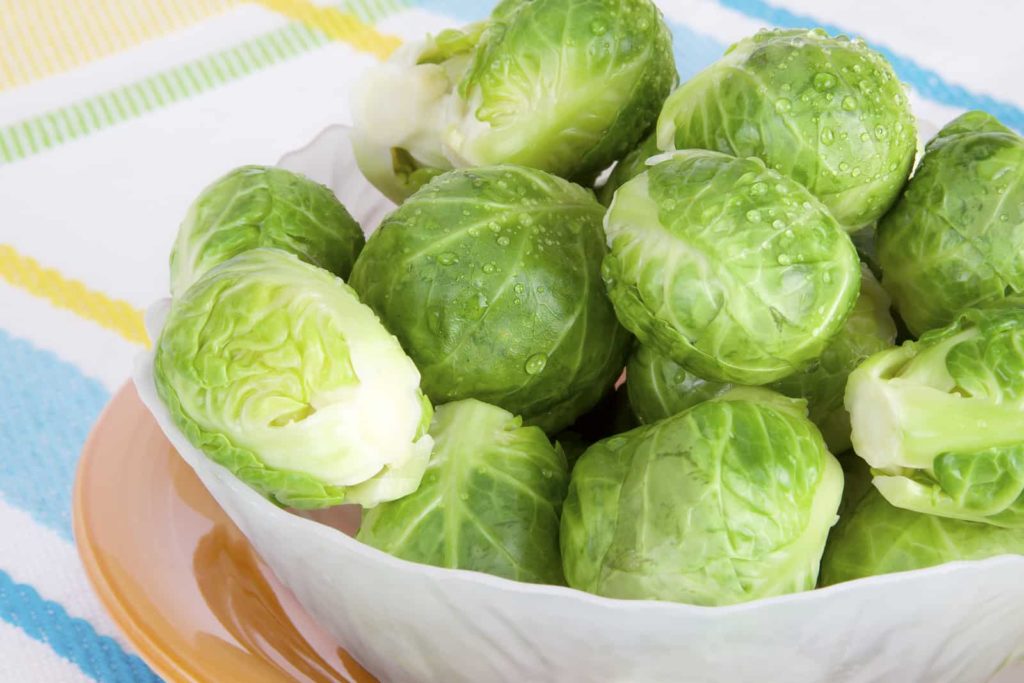
Cooked and cooled Brussels sprouts can be halved or quartered and simply added to a tossed green salad.
How to choose Brussels sprouts
- Select Brussels sprouts with small, firm, compact heads that are bright green.
- Choose sprouts that are well-formed and about 1 to 1½ inches (25-38 mm) in diameter, nearly the same size so that they will cook evenly. The smaller the sprouts the more tender they will be in the kitchen.
- Avoid Brussels sprouts that are puffy, wilted, or yellow.
- Young leaves found growing between sprout heads may be eaten as greens.
How to store Brussels sprouts
- Brussels sprouts will keep in a plastic bag in the refrigerator for 3 to 4 days. The longer they are refrigerated the stronger their flavor. Do not wash Brussels sprouts until you are ready to use them.
- You can freeze Brussels sprouts (after blanching) for up to 4 months.
Cooking Brussels sprouts
Cook Brussels sprouts until the insides are just tender, not soft, and the flavor will be sweet, mild, and delicious.
Choose Brussels sprouts that are dark green, tightly formed, and of uniform size–smaller, not bigger is best.
Cook the same day they come off the stem or use the sniff test to tell you they are fresh–avoid sprouts that are cabbagey smelling.
Many recipes tell you to slice Brussels sprouts before cooking–but they won’t be as showy as those you cook whole. Whole sprouts steamed, stir-fried, or roasted are beautiful and tasty.
To prepare whole Brussels sprouts for cooking, closely trim the stem end and remove any yellowing outer leaves. Cut an X in the stem end to bring heat to the centers more quickly.
How to prepare Brussels sprouts for cooking
- To prepare Brussels sprouts for cooking, remove the stems and loose yellow leaves; trim the dry ends.
- Wash the sprouts under running water or soak them for 15 minutes in lemon or vinegar water to get rid of hidden insects.
- If cooking sprouts whole and not halved, cut an X in each stem so that the sprouts cook evenly. Light cooking will preserve the sprout’s delicate taste.
- If halving sprouts before cooking, halve each sprout through its axis.
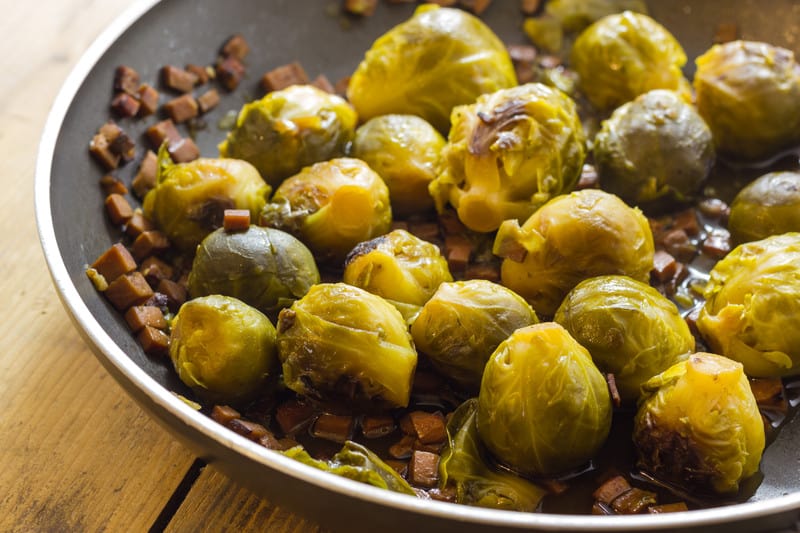
How to sauté Brussels sprouts
To butter sauté sprouts, cut the sprouts in half lengthwise. Pan fry using 2 tablespoons of butter or margarine. Cook and stir for 1 minute. Add 3 to 5 tablespoons liquid; cover and cook until the stem end is tender when pierced.
- Clean and halve 1 pound of Brussels sprouts
- Lightly coat the bottom of a heavy-bottomed frying pan with olive oil
- Heat the oil over medium-high heat.
- Add a clove or two of minced garlic and cook for 1 minute until fragrant.
- Add the Brussels sprouts and cook for 10 to 12 minutes or until tender on the inside (a sprout should be easily pierced with a paring knife); sprouts will be lightly browned on the outside.
- Season with salt and pepper to taste, and squeeze lemon over the sprouts. You can also garnish with shredded hazelnuts and freshly shredded mint, dill, or parsley leaves.
- Stir gently to combine and serve hot.
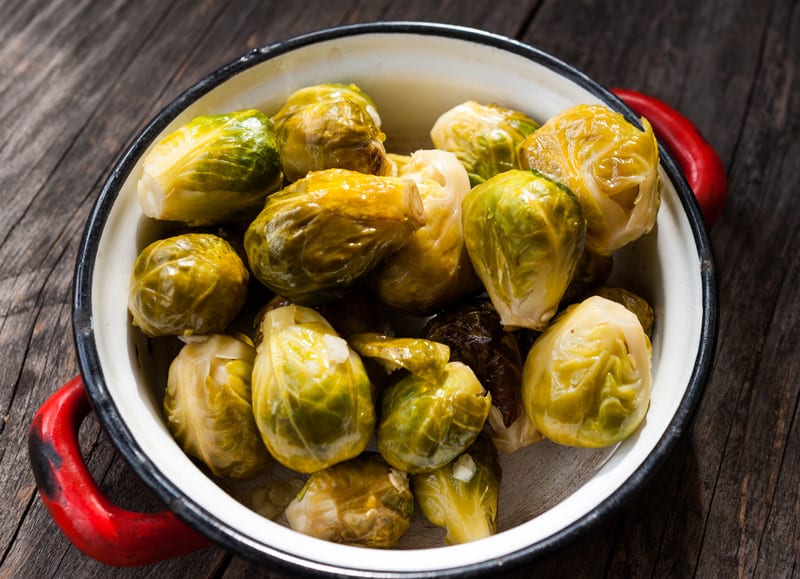
How to roast Brussels sprouts
Roasted Brussels sprouts are a combination of steaming and roasting.
Once the sprouts are steamed, put them in a large ovenproof skillet with ¼ cup of virgin olive oil added and put them in the oven. Roast for about 30 minutes occasionally shaking the pan until the sprouts are brown and tender.
Drizzle with lemon juice or balsamic vinegar and season with salt and freshly ground black pepper to taste.
Serve hot or warm.
- Clean and halve 1 pound of Brussels sprouts
- Preheat the oven to 400 degrees F.
- In a large mixing bowl, toss the sprouts with olive oil, a clove or two of minced garlic, the juice of 1 lemon, and salt and pepper to taste.
- Arrange the sprouts in one layer, cut side down, on an ungreased baking sheet or large ovenproof skillet.
- Roast for 15 to 17 minutes, until the sprouts are browned and tender on the inside.
- Drizzle with balsamic vinegar and stir if you like.
- Serve hot or warm (or refrigerate to serve cold later).
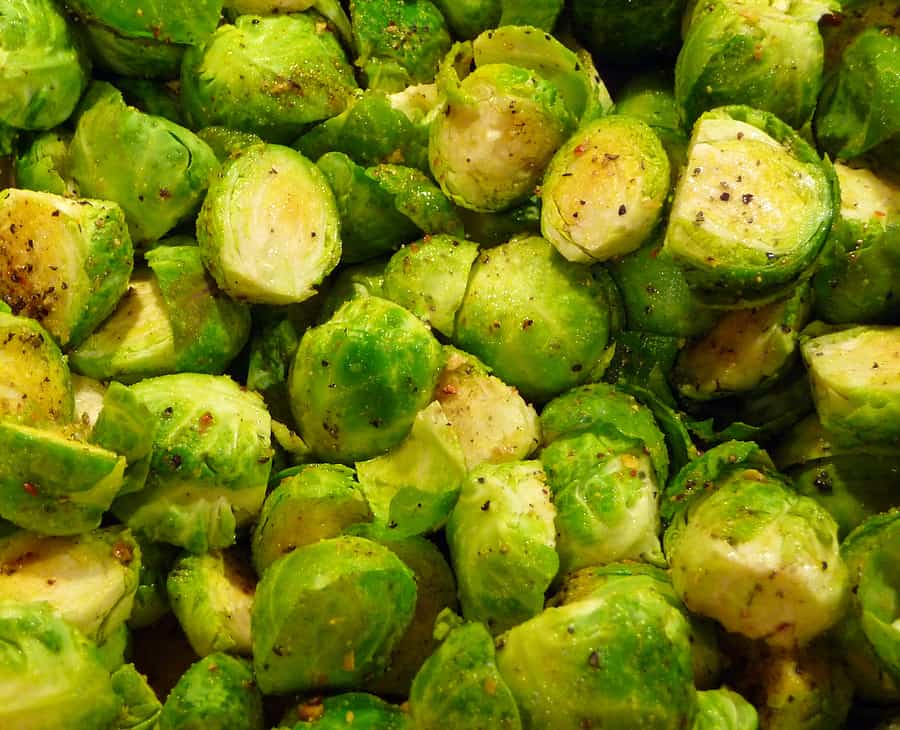
How to steam Brussels sprouts
A very easy way to steam Brussels sprouts is in a saucepan. Add ½ inch of salted water and bring to a boil. Add the Brussels sprouts, cover, and reduce the heat to medium-low. Cook until the sprouts yield to the tip of a knife and the water is just evaporated—about 5 minutes. These sprouts will offer some bite, but won’t be mushy. For the best, nutty flavor don’t over-steam Brussels sprouts—over-steamed sprouts can have a strong cabbage flavor (and smell).
The tried-and-true method of steaming Brussels sprouts is in a pot with a steamer basket. Bring about an inch of water. Put the sprouts in the steamer basket, set over the boiling water, cover, and steam until tender to the bite, about 5 minutes.
Transfer the sprouts to a bowl. Season with salt and freshly ground black pepper and toss with butter and chives. Alternatively, spritz them with lemon juice or toss them in toasted sesame oil.
Serve hot or warm.
- Clean and trim 1 pound of Brussels sprouts.
- Add a few inches of water to a pot then insert a steamer basket. The water should not touch the bottom of the steamer basket.
- Bring the water to a simmer over medium-high heat.
- Add the sprouts and steam, tossing halfway through, until bright green and tender, 6 to 8 minutes.
- Transfer the sprouts to a bowl. Season with salt and pepper to taste.
- Toss with lemon juice and also butter if you like.
- Serve hot. Steamed sprouts should be slightly crunchy. Overcooked sprouts will be mushy.
To steam Brussels sprouts, arrange the sprouts or pieces on a steamer rack. Bring 1 to 2 inches of water to a rapid boil. Place the rack in the pot and then turn the heat down to medium. Place the lid on tightly and steam until tender when pierced (5 minutes or more until tender-crisp).
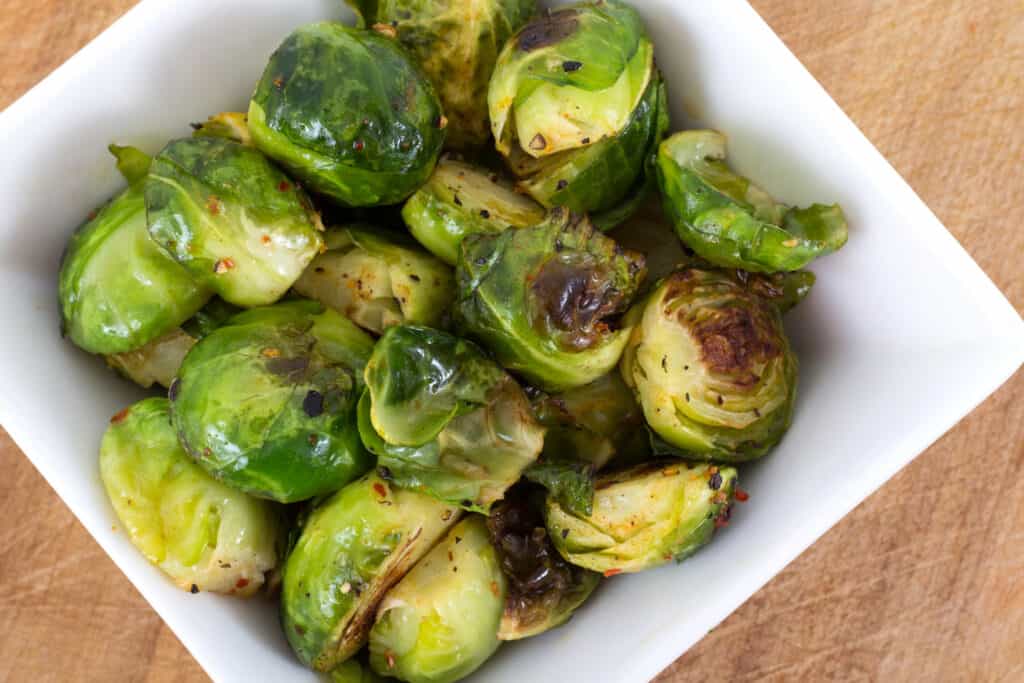
How to braise Brussels sprouts
- Clean and halve 1 pound of Brussels sprouts.
- Lightly coat the bottom of a heavy-bottomed frying pan (that has a fitted lid) with olive oil
- Heat the oil over medium-high heat.
- Add one or two cloves of garlic and cook for 1 minute until fragrant.
- Add the Brussels sprouts and cook for 2-3 minutes, until hot.
- Add 1 ½ cups of chicken broth, stir well, and cover.
- Reduce the heat to medium-low, and cook for 18-20 minutes, until the sprouts are tender. (To add a glaze to the sprouts, uncover and raise the heat to boil off the liquid with a sizzle until golden and crisp.)
- Season with salt and pepper to taste.
- Serve hot or at room temperature.
How to stir-fry Brussels sprouts
- Heat a wok or heavy pan over medium heat.
- Add a tablespoon of olive oil and bacon chopped into small bits. Cook until the bacon is brown, but not crisp. Remove the bacon with a slotted spoon and set to the side. To make this vegan, use chopped hazelnuts instead of bacon.
- To the oil add one small diced onion and cook until the onion is soft and translucent but not brown.
- Turn the heat to medium-high, add the Brussels sprouts cook, stir, and toss until the sprouts are heated through and just starting to brown—about a minute or two.
- Add the bacon (or nuts) and toss. Season with salt to taste.
- Serve hot or warm.
How to fry Brussels sprouts
- Pre-cook sprouts until tender
- Roll them in seasoned flour; then roll them again in a beaten egg and again in bread crumbs.
- Fry the sprouts in deep fat until golden brown.
More ways to serve Brussels sprouts
- Serve sprouts folded into a cheese or béchamel sauce.
- Served sprouts au gratin or added to soups, stews, or stir-fries.
- Purée the sprouts with potatoes.
- Toss cooked and cooled Brussels sprouts with diced tomatoes and a vinaigrette and serve on a bed of greens.
- Mix cooked sprouts with cooked chestnuts and butter or with almonds and sour cream.
- Braise sprouts, onions, and mushrooms in bacon fat then top with grated cheese and crumbled bacon.
How to season and serve Brussels sprouts
- Season Brussels sprouts with salt, pepper, onion, dill, oregano, marjoram, mint, allspice, nutmeg, mace, fennel, savory, celery seed, cloves, caraway, sesame seed, mustard, sage, or thyme.
- Serve Brussels sprouts alone or topped with plain for flavored butter or margarine, vinegar or vinaigrette dressing, plain or flavored mayonnaise, sour cream, plain yogurt, white sauce, stewed tomatoes, bacon or ham.
- Toss cooked and cooled Brussels sprouts with diced tomatoes and a vinaigrette and serve on a bed of greens.
- Serve Brussels sprouts as a vegetable side dish on their own or with butter or a béchamel sauce. They can also be served au gratin or added to soups, stews, or stir-fries. Brussels sprouts can be puréed with potatoes.
- Mix cooked sprouts with cooked chestnuts and butter or with almonds and sour cream.
Brussels sprouts flavor partners
- Brussels sprouts have a flavor affinity for almonds, bacon, braised chestnuts, butter, chestnuts, chicken stock, cream sauces, and shallots.
Brussels sprouts nutrition
- Brussels sprouts are high in vitamins C and A and contain potassium, iron, and fiber. Six cooked sprouts contain more than the recommended daily allowance of vitamin C.
- Six sprouts contain 36 calories.

Get to know Brussels sprouts
- Brussels sprouts are a biennial grown as a cool-season annual. They survive winter snows to push their final harvest of miniature cabbage-like sprouts in spring. Brussels sprouts can be planted in summer for autumn and winter harvest.
- The Brussels sprout is a leggy, thick-stalked plant that grows 36 to 48 inches (90-122 cm) tall with large, broad leaves. In the axils of the plant’s lower leaves, cabbage-shaped buds called sprouts or heads form. Each bud grows from ½ to 1½ inches (1.3-3.8 cm) in diameter.
- Brussels sprouts can be divided into early, mid-season, and late varieties. Early varieties are harvested in mid-fall; midseason varieties are harvested from mid-fall through mid-winter, and late varieties are harvested from mid-winter to early spring.
- Late or spring varieties yield the largest number of sprouts.
- Two well-known and sweet-tasting varieties are ‘Oliver’ which produces large buds, and ‘Rubine Red’ which produces red buds below purple leaves.
- Brussels sprouts are related to a wild variety of cabbage that originated near the Mediterranean. They are named after the city of Brussels in Belgium where they were improved through cultivation at the beginning of the nineteenth century. They were recognized by the King of Belgium as the official green of that country in 1820.
The botanical name for Brussels sprouts is Brassica oleracea var. gemmifera.
Brussels sprouts articles at Harvest to Table:
How to Plant and Grow Brussels Sprouts
Brussels Sprouts Seed Starting Tips
How to Harvest and Store Brussels Sprouts
Brussels Sprouts Growing Problems: Troubleshooting
Five Easy Ways to Cook and Serve Brussels Sprouts
More kitchen tips:
Bring your harvest to the table. Kitchen prep tips and easy recipes for the vegetables you grow. Click below for vegetable prep and recipes you can use now.
- Almonds
- Apples
- Apricot
- Aprium
- Artichoke
- Arugula
- Asparagus
- Avocado
- Bamboo Shoots
- Banana
- Basil
- Beans, Dried
- Beans. Long
- Beans, Shell
- Beans, Snap
- Beets
- Bitter Melon
- Blackberry
- Bok Choy
- Broccoli
- Broccoli Raab
- Brussels Sprouts
- Cabbage
- Cardoon
- Carrots
- Cauliflower
- Celeriac
- Celery
- Chard
- Chayote Squash
- Cherimoya
- Cherries
- Chestnut
- Chickpea
- Chinese Cabbage
- Chives
- Cilantro
- Citron
- Clementine
- Collards
- Coriander
- Corn, Sweet
- Corn, Baby
- Corn Salad, Mache
- Cranberry
- Cress
- Cucumber
- Daikon
- Dandelion
- Dill
- Eggplant
- Endive, Belgian
- Endive and Escarole
- Fava Beans
- Fig
- Florence Fennel
- Garlic
- Ginger
- Grapefruit
- Grapes
- Guava
- Horseradish
- Jerusalem Artichoke
- Jicama
- Jujube
- Kale
- Kiwifruit
- Kohlrabi
- Kumquat
- Leeks
- Lemongrass
- Lemons
- Lettuce
- Lime
- Mache (Corn Salad)
- Mandarin Orange
- Mango
- Maple Syrup
- Marjoram
- Melons
- Michihili
- Mint
- Mizuna
- Mushrooms
- Mushrooms, Cremini
- Mustard Greens
- Napa Cabbage
- Nectarine
- Okra
- Olives
- Olive oil
- Onions
- Oranges
- Oregano
- Parsley
- Parsley Root
- Parsnips
- Passion Fruit
- Pawpaw
- Peaches
- Pears
- Peas, Garden Snap
- Peas, Snow
- Pei Tsai
- Peppers, Chili
- Peppers, Sweet
- Persimmon
- Pineapple
- Pineapple Guava
- Plantain
- Plums
- Pluots
- Pomegranate
- Potatoes
- Prickly Pear
- Pumpkin
- Quince
- Radicchio
- Radishes
- Raspberries
- Rosemary
- Rhubarb
- Rutabaga
- Sage
- Salsify
- Sauerkraut
- Savory
- Shallots
- Sorrel
- Spinach
- Squash, Summer
- Squash, Winter
- Strawberries
- Sunchokes
- Sunflower
- Sweet Potato
- Swiss Chard
- Tangerine
- Taro
- Tarragon
- Thyme
- Tomatillo
- Tomato
- Turnip
- Turnip Greens
- Yams















